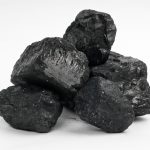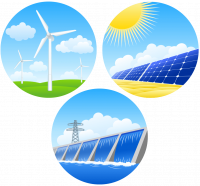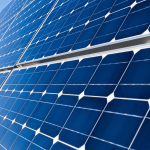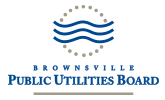Electricity FAQ (Frequently Asked Questions)
Electricity is a form of energy that starts with atoms. Atoms are too small to see, but they make up everything around us. An atom has three tiny parts: protons, neutrons, and electrons. The center of the atom has at least one proton and one neutron. At least one electron travels around the center of the atom at great speed. Electricity can be created by forcing electrons to flow from atom to atom.
Most electricity used in the United States is produced at power plants. Various energy sources are used to turn turbines. The spinning turbine shafts turn electromagnets that are surrounded by heavy coils of copper wire inside generators. This creates a magnetic field, which causes the electrons in the copper wire to move from atom to atom.
Electricity leaves the power plant and is sent over high-power transmission lines on tall towers. The very strong electric current from a power plant must travel long distances to get where it is needed. Electricity loses some of its strength (voltage) as it travels, so transformers, which boost or “step up” its power, must help it along.
When electricity gets closer to where it will be used, its voltage must be decreased. Different kinds of transformers at utility substations do this job, “stepping down” electricity’s power. Electricity then travels on overhead or underground distribution wires to neighborhoods. When the distribution wires reach a home or business, another transformer reduces the electricity down to just the right voltage to be used in appliances, lights, and other things that run on electricity.
A conductor carries the electricity from the distribution wires to the house meter box. The meter measures how much electricity the people in the house use. From the meter box, wires run through the walls to outlets and lights. The electricity is always waiting in the wires to be used.
Electricity travels in a circuit. When you switch on an appliance, you complete the circuit. Electricity flows along power lines to the outlet, through the power cord into the appliance, then back through the cord to the outlet and out to the power lines again.
Electricity travels fast (186,000 miles per second). If you traveled that fast, you could travel around the world almost eight times in the time it takes to turn on a light! And if you had a lamp on the moon wired to a switch in your bedroom, it would take only 1.28 seconds after you flipped the switch for electricity to light the lamp 238,857 miles away!
Figures used to arrive at the numbers:
• Speed of light: 186,000 miles/sec
• Average distance to the moon: 238,857 miles
• Circumference of the earth: 24,902 miles (equatorial), 24,860 miles (polar)
Volts, amps, and watts measure electricity. Volts measure the pressure under which electricity flows. Amps measure the amount of electric current. Watts measure the amount of work done by a certain amount of current at a certain pressure or voltage.
To understand how they are related, think of water in a hose. Turning on the faucet supplies the force, which is like the voltage. The amount of water moving through the hose is like the amperage. You would use lots of water that comes out really hard (like a lot of watts) to wash off a muddy car. You would use less water that comes out more slowly (like less watts) to fill a glass.
Watts = Amps x Volts
Amps = Watts ÷ Volts
There are hundreds of thousands of miles of high-voltage transmission lines in the U.S. and many hundreds of thousands more miles of distribution lines that carry electricity to our homes.
No! Someone can be shocked by electricity and survive. But when we say someone has been electrocuted, it means they have been killed by electricity.
You can’t see electricity when it is flowing through a circuit. But if electricity leaves the circuit — like when someone is shocked — you can see a spark. The spark isn’t electricity itself. It is a flame that happens when the electricity travels through the air and burns up oxygen particles.
Neither! In the wires of an electrical circuit, the electrons are always jiggling around. When a circuit is closed to run an appliance or a light bulb, the electrons jiggle a lot and travel through the wire. When the circuit is open, all the electrons just jiggle where they are — kind of like running in place.
It’s just the nature of electricity to move from an area of higher voltage to an area of lower voltage, if given a path to travel there. The ground is simply the lowest-voltage area around, so if you give electricity a path to the ground, it will take it, no questions asked! When electricity goes into the ground, the earth absorbs its energy.
It is easier for electricity to keep flowing through the power line than to go through the bird. But if a bird with large wings touches a power line and a tree or power pole at the same time, it provides electricity with a path to the ground, and could be shocked. And if a bird touches two wires at once, it will create a circuit — electricity will flow through the bird and likely electrocute it.
The shock you feel when you touch an object after walking on carpet is static electricity. When you drag your feet across carpet on a dry day, electrons from the carpet get transferred to your body. If you then touch a piece of metal, such as a doorknob, the electrons jump to the metal and you’ll feel a shock.
Lightning is a large discharge of static electricity. During a thunderstorm, clouds build up a charge. When there is a big difference in charge between the cloud and its surroundings, the cloud discharges a lightning bolt.
One lightning strike can carry between 100 million and 1 billion volts—as much electricity as 2.5 million car batteries.
Yes, it does. Because water conducts electricity, when lightning strikes water it spreads out along the surface. Any fish near the surface of the water get electrocuted.
According to Guinness World Records, Roy G. Sullivan, a former U.S. park ranger, was struck by lightning seven times over the course of his 35-year career. Lightning has burned off his eyebrows, seared his shoulder, set his hair on fire, injured his ankle, and burned his belly and chest.
Ben Franklin probably did not do his famous kite experiment the way it is usually portrayed. (Franklin never wrote about it himself, and the only description we have of it was written by another scholar, Joseph Priestley, 15 years later.) Franklin believed lightning was a flow of electricity taking place in nature. He knew of electricity’s dangers, and would probably not have risked being struck by lightning by flying his kite during a storm. It is more likely that Franklin flew his kite before the storm occurred, and that his famous key gave off an electric spark by drawing small electrical charges from the air.
There is a very small chance that a lightning strike could surge through phone lines or through the wires of an electrical appliance. If you were to touch a phone or appliance at just that moment, you could be shocked.
A chemical reaction within the battery forces electrons to move.
There is not enough voltage in a regular household battery to cause a shock. However, car batteries are powerful enough to shock so you should never tamper with them.
In the early 1980s, there were about 18 deaths a year caused by hair dryers falling into bathtubs or sinks filled with water. Since 1991, hair dryer manufacturers have been required to include GFCIs (ground fault circuit interrupters) on dryer cords. GFCIs cut off electricity to prevent serious shock. Thanks to these devices, the number of hair dryer related deaths has dropped to an average of two per year. Don’t let these statistics give you a false sense of security! Never use a hair dryer or other electric appliance near water, whether or not it has a GFCI.
Yes! An electric eel uses chemicals in its body to manufacture electricity. A large electric eel can produce a charge of up to 650 volts, which is more than five times the shocking power of a household outlet.
Inside the cells of the heart, tiny electrical currents fire in a steady rhythm. If that rhythm is disrupted due to disease or injury, a heart attack can occur. A defibrillator shocks every cell in the heart at the same time, so they all start up again in rhythm. It’s like each cell is dancing to the same beat!
The wire inside a light bulb is called a filament. It is made of tungsten, a metal that stays solid at very high temperatures. Electricity flows through the tungsten filament, causing it to heat up and glow. The glow gives off light. Inside a light bulb is a vacuum — in other words, all the air has been removed from inside the glass bulb. (If there were air inside, the wire would burn up.)
Compact fluorescent lights (CFLs) and other fluorescent light bulbs contain gases (argon and mercury vapor) that produce invisible ultraviolet (UV) light when stimulated by electricity. When the UV light hits the white phosphor coating inside the fluorescent bulb, the phosphor illuminates or “fluoresces,” changing the UV light into visible light. CFLs are very energy-efficient, using only about one-fifth the energy of a standard incandescent bulb. This is because all of the electricity they use goes toward creating light, whereas the energy used by standard incandescent bulbs creates heat as well as light.
Like their energy-efficient cousins, CFLs, LEDs don’t waste energy on heat so they don’t get especially hot. But unlike CFLs, LEDs are illuminated solely by the movement of electrons in a semiconductor material. A semiconductor is a material with electrical conductivity (meaning the ability to transfer electrical energy) between that of a conductor and an insulator (hence the prefix “semi”). Inside an LED, when an electrical current passes through the semiconductor material, electrons move through the material and drop to other energy levels, and in the process they emit photons of light. LEDs are becoming an increasingly important and common light source because of their high degree of energy efficiency.
Producing Electricity
The energy resources used to generate electricity can be divided into two categories:
Nonrenewable Resources
Nonrenewable resources cannot be replenished. We can make these supplies last longer by using them wisely, but when they are gone we will not have any more.
Fossil Fuels
The majority of electricity used in the United States is generated at power plants that burn fossil fuels to heat water and make steam. The steam is highly pressurized and directed at turbine blades to make them spin.
The three forms of fossil fuels are coal, oil, and natural gas. They are known as fossil fuels because they were formed in the earth from the remains of organic matter like animals or plants that lived long ago.
 Coal is a hard, black, rock-like substance made up of carbon, hydrogen, oxygen, nitrogen, and sulfur. The precursor to coal, called peat, is used as an energy source in many countries. Coal is found in many parts of the U.S. and throughout the rest of the world. Coal is extracted from the ground at large mines.
Coal is a hard, black, rock-like substance made up of carbon, hydrogen, oxygen, nitrogen, and sulfur. The precursor to coal, called peat, is used as an energy source in many countries. Coal is found in many parts of the U.S. and throughout the rest of the world. Coal is extracted from the ground at large mines.
 Oil is a liquid fossil fuel, sometimes also called petroleum. It is found underground within porous rocks. Oil rigs must drill down to deposits deep below the earth’s surface to obtain oil. More than half of all the oil we use in the United States comes from outside our country.
Oil is a liquid fossil fuel, sometimes also called petroleum. It is found underground within porous rocks. Oil rigs must drill down to deposits deep below the earth’s surface to obtain oil. More than half of all the oil we use in the United States comes from outside our country.
 Natural gas is made up primarily of a gas called methane. Methane gas is highly flammable and burns very cleanly. Natural gas is usually found underground along with oil. Natural gas supplies are abundant from sources in the United States and Canada.
Natural gas is made up primarily of a gas called methane. Methane gas is highly flammable and burns very cleanly. Natural gas is usually found underground along with oil. Natural gas supplies are abundant from sources in the United States and Canada.
Nuclear Power
 Nuclear power plants use the heat from splitting atoms to convert water into the steam that turns turbines. These plants rely on uranium, a type of metal that must be mined from the ground and specially processed. Fuel rods containing uranium are placed next to each other in a machine called a nuclear reactor. The reactor causes the uranium atoms to split, and in so doing, they release a tremendous amount of heat.
Nuclear power plants use the heat from splitting atoms to convert water into the steam that turns turbines. These plants rely on uranium, a type of metal that must be mined from the ground and specially processed. Fuel rods containing uranium are placed next to each other in a machine called a nuclear reactor. The reactor causes the uranium atoms to split, and in so doing, they release a tremendous amount of heat.
Renewable Resources
Renewable energy resources can be replenished in a short period of time, so they will never be all used up. Energy companies throughout the country are using renewable resources more and more to generate electricity.

Biomass
Biomass is organic matter, such as agricultural waste, and wood chips and bark left over when lumber is produced. Biomass can be burned to heat water to make steam, which turns a turbine to make electricity. It can also be converted into a gas, which can be burned to do the same thing.
 Biomass includes energy crops like wood, straw, and other crops grown primarily for use as a fuel. Energy crops are renewable, but some, like trees, take a long time to grow. Farmers can grow trees on some of their land instead of wheat or other kinds of food. The wood is harvested regularly, cut into small chips and burned to provide heat or run small electric power plants.
Biomass includes energy crops like wood, straw, and other crops grown primarily for use as a fuel. Energy crops are renewable, but some, like trees, take a long time to grow. Farmers can grow trees on some of their land instead of wheat or other kinds of food. The wood is harvested regularly, cut into small chips and burned to provide heat or run small electric power plants.
A fuel generated from biomass is methane gas, a by–product of decay in landfills. As garbage rots in the ground, it gives off gases that can be collected and burned to produce heat or electricity.
Geothermal Energy
 The word geothermal comes from the Greek words geo, for earth, and therme, for heat. So geothermal means “earth heat.” Geothermal energy is steam (or hot water that has been converted to steam) from deep inside the earth.
The word geothermal comes from the Greek words geo, for earth, and therme, for heat. So geothermal means “earth heat.” Geothermal energy is steam (or hot water that has been converted to steam) from deep inside the earth.
Our planet’s interior is very hot — at its core, 4,000 miles deep, temperatures may reach over 9,000°F. This heat is continuously conducted from the earth’s core to the surrounding layer of rock, the mantle.
There are some places around the earth where magma (hot molten earth from the mantle) pushes up through cracks into the crust near the earth’s surface. Magma can heat nearby rock and water as hot as 700°F. Some of this hot water reaches the earth’s surface as hot springs or geysers, and some stays trapped deep underground in cracks and porous rocks. This hot water can be used directly or converted into steam to turn turbines that generate electricity.
Hydrogen
 Hydrogen is a colorless, odorless gas. Hydrogen can be converted into electricity through a chemical reaction in a device called a fuel cell. Converting hydrogen into electricity produces no pollution — only water and heat.
Hydrogen is a colorless, odorless gas. Hydrogen can be converted into electricity through a chemical reaction in a device called a fuel cell. Converting hydrogen into electricity produces no pollution — only water and heat.
If the hydrogen comes from a renewable resource like landfill gas, fuel cells are considered renewable. However, if it comes from a nonrenewable resource like fossil fuels, fuel cells are considered nonrenewable. Whether a fuel cell is using a renewable energy source depends on the source of the hydrogen fuel.
Today, there are already some cars that run on hydrogen. In the future, hydrogen will be used to fuel vehicles and airplanes and to provide electricity to buildings.
Hydropower
 Hydroelectric plants use the power of falling water to turn the turbines that help generate electricity. Water that is stored behind a dam is released and directed through special tubes to flow against the blades of turbines and make them turn. Most hydropower facilities are found in hilly or mountainous areas. The most famous hydroelectric facility in the country is Hoover Dam.
Hydroelectric plants use the power of falling water to turn the turbines that help generate electricity. Water that is stored behind a dam is released and directed through special tubes to flow against the blades of turbines and make them turn. Most hydropower facilities are found in hilly or mountainous areas. The most famous hydroelectric facility in the country is Hoover Dam.
Ocean Energy
 Ocean energy is a form of hydropower. Oceans cover more than 70 percent of the earth’s surface, making them the world’s largest solar collectors. The ocean stores thermal (heat) energy, which can be used to generate electricity using special turbine generators.
Ocean energy is a form of hydropower. Oceans cover more than 70 percent of the earth’s surface, making them the world’s largest solar collectors. The ocean stores thermal (heat) energy, which can be used to generate electricity using special turbine generators.
The energy of the ocean’s waves and tides can also be used to generate electricity with dams that force ocean water through turbines. This is called tidal energy, or wave power. The world’s first wave power station is on the Scottish island of Islay. It generates enough electricity for about 400 homes.
Scientists and engineers around the world are working on systems to use the ocean’s energy on a large scale.
Solar Energy
 Solar energy is generated without a turbine or electromagnet. Special panels of solar cells, or modules, can capture sunlight and convert it directly into electricity. These panels are known as photovoltaic, or PV. (Photo is Greek for light, and voltaic pertains to electricity.) The electricity they produce can be used right away, fed into the power grid for others to use, or stored in a battery so it is also available on cloudy days.
Solar energy is generated without a turbine or electromagnet. Special panels of solar cells, or modules, can capture sunlight and convert it directly into electricity. These panels are known as photovoltaic, or PV. (Photo is Greek for light, and voltaic pertains to electricity.) The electricity they produce can be used right away, fed into the power grid for others to use, or stored in a battery so it is also available on cloudy days.
Wind Power
 Wind power is renewable energy that uses the force of the wind to spin turbines. These spinning turbines generate electricity.
Wind power is renewable energy that uses the force of the wind to spin turbines. These spinning turbines generate electricity.
Most wind power is produced at wind farms, which are large groups of turbines in consistently windy locations. A very large wind farm can generate enough electricity for all the homes in a city of about one million people. Small wind turbines can be used for individual homes, businesses, and boats. They can be used to pump water, or the electricity can be stored in large batteries for use at another time.
Pioneers of Electricity
Electric Vehicles
Electric vehicles (EVs) run on electrical energy instead of — or in addition to — gasoline. Industry experts anticipate there will be over a million EVs on the roads this decade. They are popular for many reasons:
- EVs use the latest car technology.
- EVs can help reduce pollution.
- EVs can cost less to run than gasoline vehicles.
Battery Electric Vehicles
Battery EVs run entirely on electrical energy. Instead of a fuel tank, batteries store the electricity that is used to operate the vehicle. These batteries can be recharged by plugging the vehicle into a special high-voltage charging station or standard 120-volt or 240-volt household outlets. It takes anywhere from 2 to about 20 hours to recharge the battery, depending on the vehicle’s charger and the voltage used. The batteries store the electricity until the vehicle is driven.
 Early types of battery EVs included golf carts, scooters, and other vehicles used for short trips at low speeds. With rapid industry growth this decade, battery EVs can accommodate both city and highway driving needs. Smaller models designed for urban use can travel 30-75 mph and go 50-85 miles on a charge. The high-end Tesla can reach speeds of 150 mph and travel more than 300 miles on a single charge.
Early types of battery EVs included golf carts, scooters, and other vehicles used for short trips at low speeds. With rapid industry growth this decade, battery EVs can accommodate both city and highway driving needs. Smaller models designed for urban use can travel 30-75 mph and go 50-85 miles on a charge. The high-end Tesla can reach speeds of 150 mph and travel more than 300 miles on a single charge.
Under the hood, a battery EV consists of an electric motor, one or more controllers, and batteries. The controller governs the amount of electricity that flows from the batteries to the motor when the driver steps on the accelerator. The motor changes electrical energy from the batteries to mechanical energy, which makes the vehicle move.
 Driving a battery EV down the road produces no pollution at all. Even when pollution related to power plant electricity production is factored in, these EVs produce less pollution than gasoline- or diesel-powered vehicles. Battery EVs are also more efficient than gasoline or diesel vehicles, if you compare the energy used in creating gasoline at a refinery to producing electricity in a power plant.
Driving a battery EV down the road produces no pollution at all. Even when pollution related to power plant electricity production is factored in, these EVs produce less pollution than gasoline- or diesel-powered vehicles. Battery EVs are also more efficient than gasoline or diesel vehicles, if you compare the energy used in creating gasoline at a refinery to producing electricity in a power plant.
 When a battery EV is stopped in traffic, it doesn’t have to use fuel to keep the motor running like a gasoline engine does. Added efficiency is created by something called “regenerative braking.” When the vehicle slows down, the motor continues to turn, but the power no longer flows to the wheels. Instead, the power is fed back to the batteries, giving them a small charge every time the driver stops or goes downhill.
When a battery EV is stopped in traffic, it doesn’t have to use fuel to keep the motor running like a gasoline engine does. Added efficiency is created by something called “regenerative braking.” When the vehicle slows down, the motor continues to turn, but the power no longer flows to the wheels. Instead, the power is fed back to the batteries, giving them a small charge every time the driver stops or goes downhill.
Hybrid Electric Vehicles
A hybrid electric vehicle (HEV) uses two or more power sources. Most HEVs run on both a gasoline engine and an electric motor. They are similar in size and comfort level to the most popular gasoline-powered vehicles. There are now over 60 models of HEVs on the market, with the Toyota Prius remaining the top-selling HEV since its introduction in 2000.
The major components of an HEV include a gasoline engine, an electric motor, a transmission, and, in some models, a generator. A fuel tank stores gasoline for the engine, and a battery pack stores electricity for the motor. The battery is charged by the gasoline engine and by the electric motor or generator during normal operation. Regenerative braking charges the batteries slightly when the car slows down, recovering some of the energy.
Plug-in Hybrid Electric Vehicles
 Another type of hybrid electric vehicle is the plug-in hybrid, or PHEV. These vehicles have two power systems, an internal combustion engine and a battery. Unlike the regular hybrids such as the Toyota Prius, the PHEV’s battery can be recharged either by the gas engine or by plugging the vehicle into an external source of electricity. Some PHEVs are known as extended-range electric vehicles, or EREVs, because their secondary power source provides enough fuel to allow the vehicle to drive for hundreds of miles when the batteries become low.
Another type of hybrid electric vehicle is the plug-in hybrid, or PHEV. These vehicles have two power systems, an internal combustion engine and a battery. Unlike the regular hybrids such as the Toyota Prius, the PHEV’s battery can be recharged either by the gas engine or by plugging the vehicle into an external source of electricity. Some PHEVs are known as extended-range electric vehicles, or EREVs, because their secondary power source provides enough fuel to allow the vehicle to drive for hundreds of miles when the batteries become low.
All types of hybrid EVs use smaller, more efficient gasoline engines than conventional gasoline or diesel vehicles. They also burn less fuel than conventional vehicles, thus producing fewer pollutants and releasing less carbon dioxide into the air.
Use Energy Wisely at Home
About one-third of all electricity produced at power plants in the United States is used in the home. Families that reduce their electricity use by avoiding waste and buying energy-efficient appliances save money and help preserve natural resources used to generate electricity.
Show your parents this list of ways to be energy-efficient and save money on your energy bills every month. Maybe you can persuade them to pass the cost savings on to you!
Use Energy Wisely at School
Most schools spend more money on energy than on computers and textbooks combined. Here’s how you can help your school reduce energy waste.




















